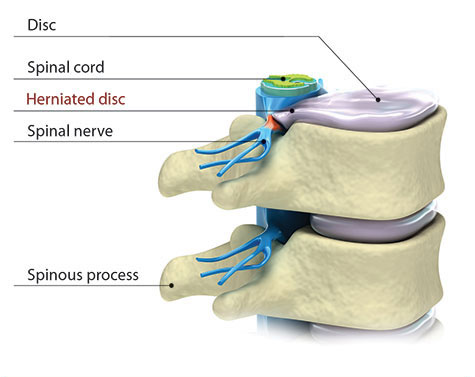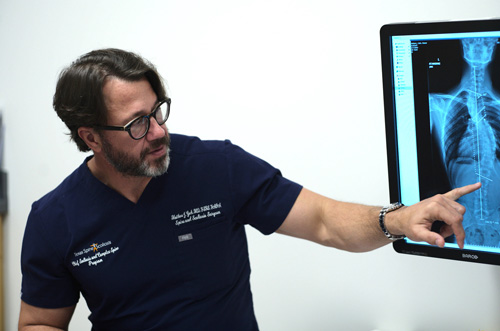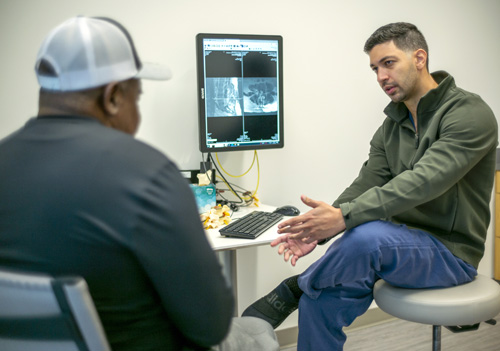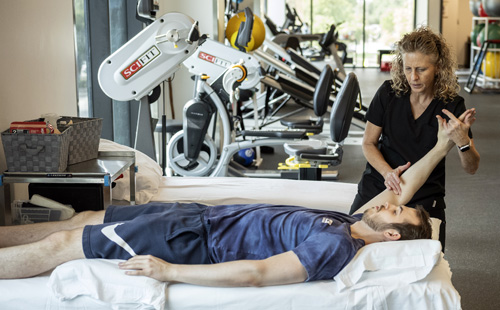
Learn about the shock-absorbing discs that separate the bones in the spine.
Overview | Causes | Symptoms | Diagnosis | Treatment | FAQ
Kyphosis and lordosis are types of spinal deformities. While slight curvature of the spine is normal and healthy, there are some cases where it is over-pronounced and can cause both cosmetic deformity and health risks. Lordosis occurs when the spine curves too far inward in the low back. Kyphosis occurs when the spine in the shoulder blade area curves forward more than normal. Individuals with kyphosis may have visible humps in their back. Kyphosis or Scheuermann’s disease most often occurs in the thoracic area of the spine and is often noticed as adolescent roundback or stooping.
A normal kyphosis curvature is 40 degrees in young adults. Curves over 70 degrees are often associated with more lifelong pain and may result in a more sedentary profession than normal patients.
Some people are born with kyphosis when there is a naturally occurring abnormality in the spine. Kyphosis can also be an acquired condition. Teenagers in particular may develop kyphosis due to bad posture, especially girls between the ages of 12 and 15. Adolescent and adult kyphosis is called Scheuermann's disease.
 Compression fractures are often linked to the development
of many cases of adult kyphosis, because they cause vertebrae to become
wedged, reducing the amount of space between each vertebra. These fractures
can occur as the result of degenerating discs, arthritis, osteoporosis
and spondylolisthesis. Individuals with osteoporosis may develop kyphosis
due to a weakening and compression in the vertebrae. Kyphosis in these
individuals is treated with aggressive anti-osteoporosis action to
prevent further bone weakening.
Compression fractures are often linked to the development
of many cases of adult kyphosis, because they cause vertebrae to become
wedged, reducing the amount of space between each vertebra. These fractures
can occur as the result of degenerating discs, arthritis, osteoporosis
and spondylolisthesis. Individuals with osteoporosis may develop kyphosis
due to a weakening and compression in the vertebrae. Kyphosis in these
individuals is treated with aggressive anti-osteoporosis action to
prevent further bone weakening.
Other causes may include previous lumbar surgery with fusion for back pain, scoliosis or stenosis. This lumbar fusion may lead to “flatback” or permanent stooping. In these patients spinal balance issues can go unnoticed and a flatback result. A previous failed surgery on the spine may also lead to kyphosis.
The symptoms of kyphosis are similar to those of scoliosis. These include
uneven shoulders, chest, hips, shoulder blades, waist, or a tendency
to lean to one side. In other cases, there are no visible symptoms.
To diagnose a person with scoliosis, have them touch their toes.
If either one or both shoulder blades are prominent, the waist is
shifted or ribs are uneven, kyphosis may be present. Kyphosis is
also called “hunchback” because of the hunched over appearance
often seen in patients. Other symptoms include fatigue and difficulty
breathing.
[Top]
Outlined below are some of the diagnostic tools that your physician may use to gain insight into your condition and determine the best treatment plan for your condition.
 Electrodiagnostics: Electrical testing of the nerves
and spinal cord may be performed as part of a diagnostic workup.
These tests, called electromyography (EMG) or somato sensory evoked
potentials (SSEP), assist your doctor in understanding how your nerves
or spinal cord are affected by your condition.
Electrodiagnostics: Electrical testing of the nerves
and spinal cord may be performed as part of a diagnostic workup.
These tests, called electromyography (EMG) or somato sensory evoked
potentials (SSEP), assist your doctor in understanding how your nerves
or spinal cord are affected by your condition.
When treating kyphosis, the cause of the disease must first be considered.
Some cases require surgery early on, while other times, bracing and
physical therapy may be the best course of action. Although bracing
can help reduce pain symptoms, it is less successful at fixing the
underlying problem of a curved spine, especially in adults. Bracing can be used for progressing curve in skeletally immature patients. Strengthening
and stretching programs can be successful at reducing symptoms. Swimming
and other low-impact forms of exercise are beneficial. In cases which
require surgical intervention, such as a large or progressive deformity, the goal is to reduce the curvature
and relieve pain and discomfort over a long period of time.
[Top]
The common type of surgery for kyphosis used to be a large anterior and posterior surgery. Today, the condition may be treated with a less invasive posterior-only Ponte procedure, click here to learn more.
Surgery is always treated as a last resort, while more conservative methods are tried first. In general, surgery is considered when the curve exceeds 75 degrees. Other cases in which surgery may be recommended are for those suffering from chronic pain and/or a rapidly progressive curve.
Strengthening the back muscles can help prevent poor posture, which
can lead to kyphosis. Osteoporosis, which can also cause kyphosis,
can be prevented by getting enough calcium and vitamin D, exercising
and strength training regularly.
[Top]
Click here to download |
Click here to download |